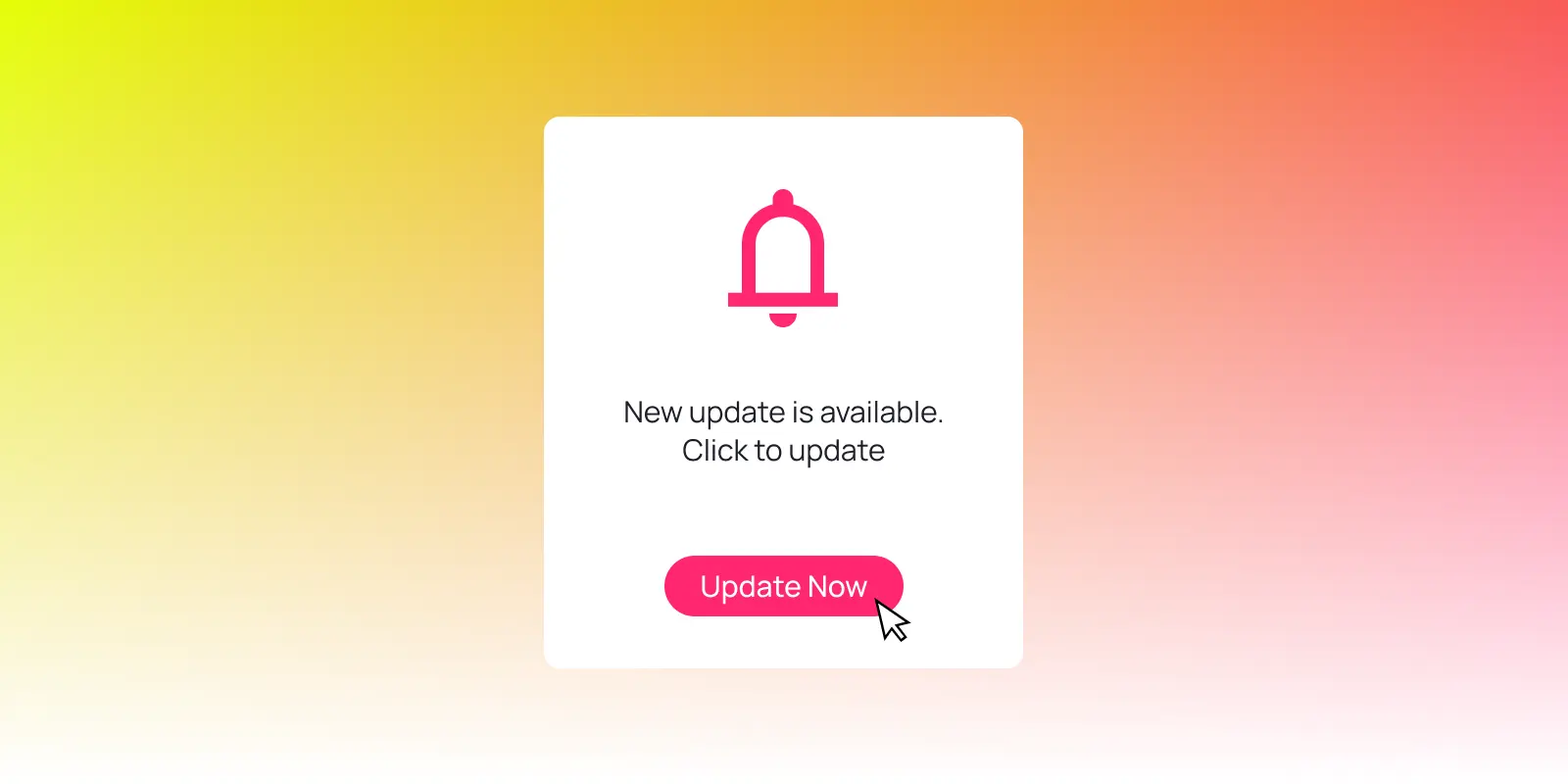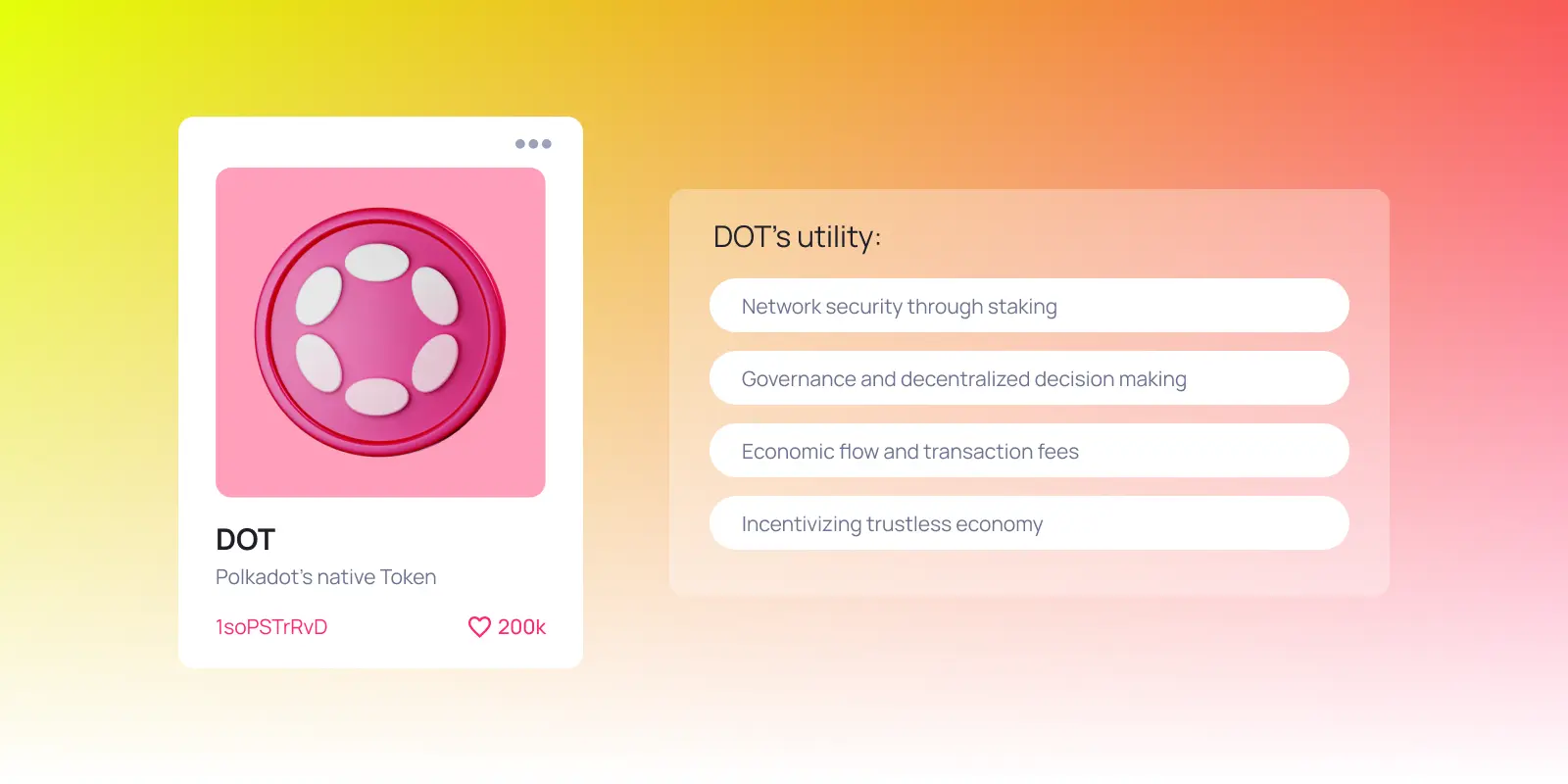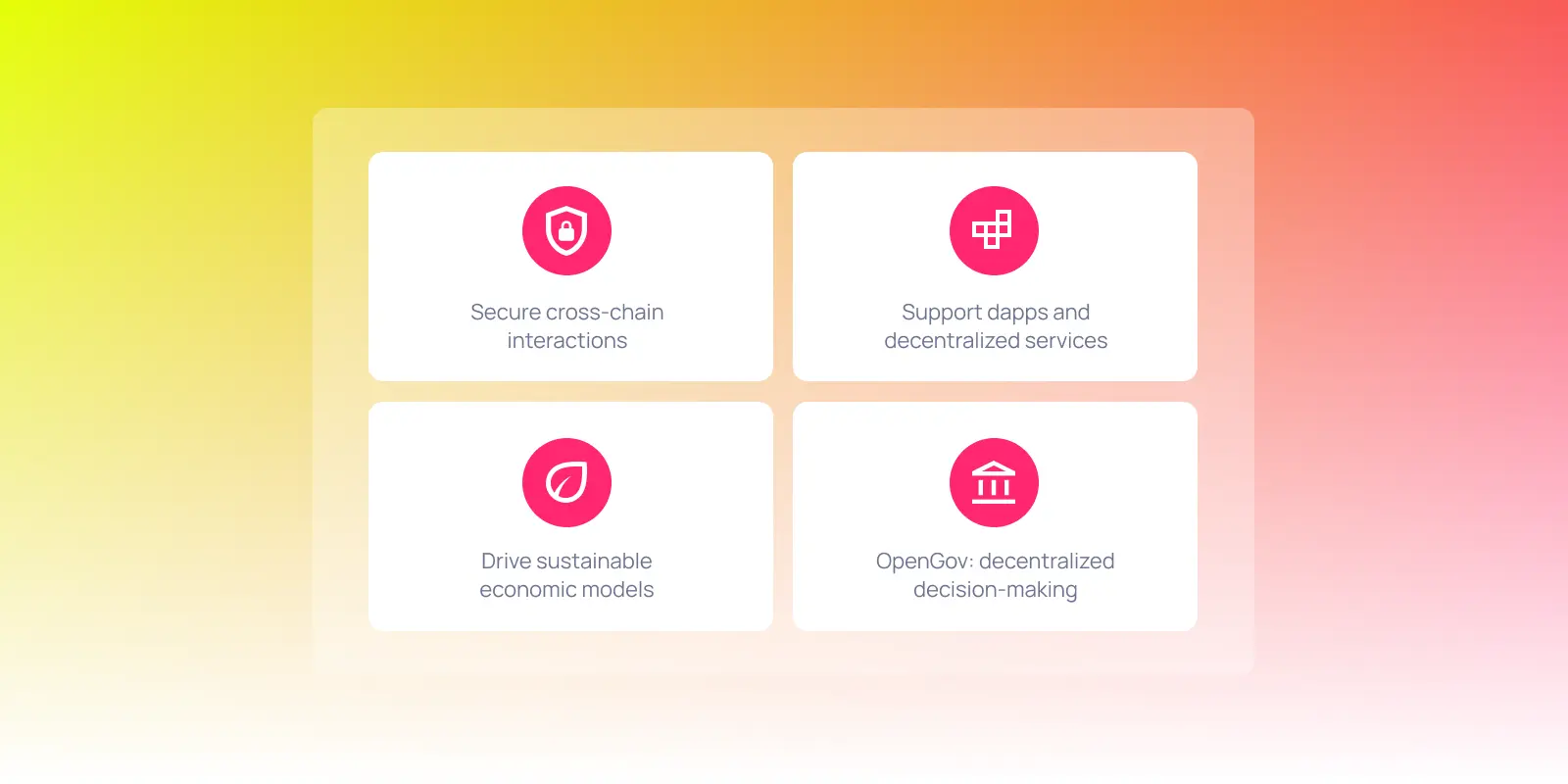What’s in a DOT? The fuel powering Polkadot's decentralized economy
DOT is more than just a token. It keeps the Polkadot network secure, runs onchain governance, and supports builders and users alike. Discover how it works and what it means for you.
 By Meesh Nguyen•April 8, 2025
By Meesh Nguyen•April 8, 2025
What you can expect
- What DOT is and how it functions
- Who uses DOT and the roles they play in the ecosystem
- How DOT works to support security, governance, and economic flow
- Expanding token utility in Polkadot's ecosystem
- Real-world use cases for DOT
- DOT vs. other native blockchain tokens
- Getting started and what to do with DOT
The real test for any blockchain isn’t how it starts but how it grows, adapts, and stays resilient. But what gives a decentralized network its strength and staying power? It’s more than just code or infrastructure. Longevity comes from how people coordinate, contribute, and keep the network moving forward together.
That’s where DOT comes in.
From securing the network to powering governance and fueling developer access, DOT is more than a digital currency. It’s the foundation that makes Polkadot’s decentralized design possible.
In Polkadot’s modular blockchain architecture, DOT plays a vital role in maintaining security, facilitating operations, and ensuring that the ecosystem remains open, decentralized, and accessible to everyone.
What is DOT? Polkadot's native token
DOT is the native token of Polkadot, a modular blockchain network built to connect and secure a growing ecosystem of specialized rollups and dapps. Unlike many digital assets, DOT has tangible, critical functions that make Polkadot secure, decentralized, and operationally sustainable.
DOT’s role is integral to maintaining Polkadot’s core operations, governance, and network security. Think of DOT as the fuel that powers the decentralized engine of Polkadot, so it can run smoothly and effectively.
A brief history of DOT

DOT token launched alongside the Polkadot network in 2020 and has undergone several milestones since. One of the most notable events was the DOT redenomination in August 2020, which increased the total supply by 100 times without affecting its market cap. This change made DOT more accessible and easier to use.
Over the years, DOT’s role has matured. It evolved from just supporting staking and governance to becoming the key to accessing shared security on the Polkadot Chain (formerly known as the Relay Chain), funding coretime for rollups via Agile Coretime, and community-driven innovation through OpenGov.
Who uses DOT and why it matters
Like many blockchain networks, Polkadot relies on its native token, DOT, to secure the network and coordinate activity among participants. It flows through the system, connecting the people and stakeholders that make the network work.
- 🛡️ Validators and nominators: Stake DOT to secure the network and maintain consensus.
- 🛠️ Developers and teams: Use DOT to access compute (aka coretime) and build on Polkadot.
- 🗳️ Governance participants: Anyone can vote with DOT to help guide the direction of the network.
From infrastructure to innovation, DOT empowers the builders, stewards, and contributors who keep Polkadot moving forward.
How DOT works in the Polkadot economy

After exploring who uses DOT across the Polkadot ecosystem, it's time to dig into how it actually works. From securing the network to enabling governance and resource access, DOT plays a central role in coordinating activity across Polkadot.
Securing the network through staking
Polkadot uses a Nominated Proof-of-Stake (NPoS) consensus model. Validators stake DOT to secure the network and verify transactions. Nominators back trustworthy validators by staking their own DOT, sharing in staking rewards. This model secures the network without the energy demands of proof-of-work (pow) models and prevents validator centralization. Any DOT holder can nominate validators, which spreads influence more evenly and lowers the chance of a single group gaining outsized control.
Powering decentralized governance
DOT holders influence Polkadot’s direction through onchain governance. Anyone with DOT can vote on proposals, upgrades, and policy changes. This is part of Polkadot’s broader approach to decentralization, where decision-making is in the hands of the community—not centralized teams.
While many DAOs manage governance offchain, Polkadot takes this a step further. OpenGov functions like a protocol-level DAO—removing centralized intermediaries and giving every DOT holder the ability to propose, vote on, and shape the network’s future.
Driving the trustless economy
DOT plays a critical role in Polkadot’s economic flow. It’s used to pay transaction fees, sometimes called gas fees, access compute resources, and reward validators and nominators. These fees fund network operations, prevent spam, and incentivize validators, helping to maintain active and reliable participation from all corners of the network.
Instead of relying on trust or central control, Polkadot’s economy runs on built-in deterrents and rewards. Bad actors face real economic consequences, like losing their staked DOT, while those who support network-positive behavior are rewarded. This structure turns DOT into a trustless coordination layer that keeps the network efficient and resilient.
How DOT is expanding utility in Polkadot
DOT’s functionality is continuously evolving to support the growing Polkadot ecosystem.
Agile Coretime: flexible resource access
Agile Coretime is a new way for developers to access Polkadot’s shared security model. Instead of long-term leases via parachain slot auctions, projects can now purchase blockchain compute resources, called coretime, on-demand using DOT. The upgrade provides flexibility and lowers the barriers to entry for startups and projects to build with Polkadot.
DOT drives real-world use cases

DOT does more than keep the network running. It gives builders, communities, and users the tools they need to collaborate and create real value across Polkadot and beyond.
- 🔐 Secure cross-chain interactions: Polkadot’s interoperability depends on DOT-based staking and governance.
- 🧱 Scale dapps and decentralized services: Developers use DOT to access Polkadot’s infrastructure and run applications.
- ♻️ Support sustainable economic models: Incentives tied to DOT encourage honest participation and decentralization.
Projects in Polkadot’s growing ecosystem, from AI and DeFi to gaming and real-world assets, rely on DOT’s functionality to stay secure, connected, and in sync with the network.
OpenGov and DOT: onchain decentralized decision-making
Polkadot’s OpenGov protocol is one of the most advanced decentralized governance frameworks in Web3. It reinforces the concept of DAOs by making decentralized governance not just a structure but a core part of the protocol itself. Rather than relying on offchain coordination or external tooling, OpenGov is baked directly into Polkadot's logic, ensuring that collective decision-making remains transparent, immutable, and enforced entirely onchain.
The system is designed to encourage participation from anyone in the community, no matter how much DOT they hold. While large token holders, or whales, can carry more weight through stake-weighted voting, OpenGov includes built-in mechanisms to ensure that a broad range of voices can participate and be heard.
How DOT compares to other native tokens
Many blockchain networks have native tokens, but DOT’s design emphasizes flexibility and adaptability.
- Ethereum’s ETH is used primarily for gas fees and staking, with governance occurring offchain.
- Solana’s SOL supports staking and transactions but has limited governance participation.
- Cosmos’ ATOM enables staking and governance but operates on a hub-and-zone model, unlike Polkadot’s shared security model.
DOT stands apart by combining onchain governance, secure staking, and access to cost-effective compute resources—all tied to a single token.
What can you do with DOT?
To participate in Polkadot’s decentralized economy, the first step is securing a wallet that supports DOT. Your wallet is where you will hold, manage, and actively use DOT to participate in staking and governance.
Types of wallets that support DOT
- Crypto wallets: These wallets can be custodial or non-custodial and allow you to securely manage digital assets like DOT. They also let you connect to dapps and interact with the Polkadot network. Crypto wallets come in various forms, including browser extensions, mobile apps, or hardware devices.
- Native staking wallets: Wallets like Nova Wallet and SubWallet are created specifically for the Polkadot ecosystem. They provide an easy-to-use interface for staking DOT and participating in governance by voting on referenda.
How to get started
- Choose a wallet: Select a crypto wallet that supports DOT and meets your preferences for security and usability.
- Set up your wallet: Follow setup instructions to create a new wallet and securely store your recovery phrase.
- Fund your wallet with DOT: Purchase DOT through a trusted crypto exchange and send it to your wallet.
- Stake DOT or vote in governance: Once your wallet is funded, you can participate in staking to earn rewards or vote on network proposals.
For more information and step-by-step instructions, explore our guides on crypto wallets, native staking wallets, and how to set up a Polkadot-compatible wallet.
DOT is for everyone
At the core of Polkadot’s decentralized economy is DOT—a token designed to power more than just transactions. DOT secures the network, enables onchain governance, and fuels the activity of developers, builders, and everyday participants. As Polkadot’s technology evolves, so does DOT’s utility—opening up new ways to contribute, collaborate, and innovate.
Whether you want to help secure the network through staking, shape its direction through governance, integrate with Polkadot’s expanding ecosystem, or start building the next generation of dapps—it all starts with DOT.
No matter how you choose to get involved, there’s a place for you in Polkadot’s growing economy.











